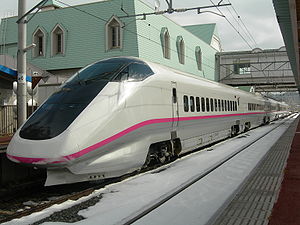Genbi Shinkansen
| E3 series | |
|---|---|

An E3 series set on an Akita Shinkansen Komachi service in March 2008
|
|
| In service | 1997–present |
| Manufacturer | Kawasaki Heavy Industries, Tokyu Car Corporation |
| Family name | Mini-shinkansen |
| Constructed | 1995–2009 |
| Scrapped | 2013– |
| Number built | 261 vehicles (41 sets) |
| Number in service | 129 vehicles (19 sets) (as of 1 October 2016[update]) |
| Number scrapped | 132 vehicles |
| Formation | 6 or 7 cars per trainset |
| Fleet numbers | R1–R26, L51–L55, L61–L72 |
| Capacity |
6-car R sets: 338 (23 Green + 315 Standard) 7-car L50 sets (E3-1000): 402 (23 Green + 379 Standard) 7-car L60 sets (E3-2000): 394 (23 Green + 371 Standard) |
| Operator(s) | JR East |
| Depot(s) | Akita, Yamagata |
| Line(s) served | Tohoku Shinkansen, Yamagata Shinkansen, Joetsu Shinkansen |
| Specifications | |
| Car body construction | Aluminium |
| Car length | 20,050 to 23,070 mm (65 ft 9 in to 75 ft 8 in) |
| Width | 2,945 mm (9 ft 8 in) |
| Doors | 1 per side |
| Maximum speed | 275 km/h (171 mph) (Tohoku Shinkansen), 130 km/h (81 mph) (Akita/Yamagata Shinkansen) |
| Traction system | GTO or IGBT-VVVF (6-car sets: 16 x 300 kW, 7-car sets: 20 x 300 kW) |
| Power output |
6-car sets: 4.8 MW (6,440 hp), 7-car sets: 6 MW (8,050 hp) |
| Acceleration | 1.6 km/h/s |
| Electric system(s) | 20/25 kV AC, 50 Hz overhead catenary |
| Current collection method | Pantograph |
| Safety system(s) | ATC-2, DS-ATC, ATS-P |
| Multiple working | 200 series, E2 series, E4 series, E5 series |
| Track gauge | 1,435 mm (4 ft 8 1⁄2 in) |
The E3 series (E3系?) is a Japanese Shinkansen high-speed train type built for Komachi services which commenced on 3 June 1997, coinciding with the opening of the new Akita Shinkansen "mini-shinkansen" line, a regular 1,067 mm (3 ft 6 in) narrow-gauge line between Morioka and Akita re-gauged to 1,435 mm (4 ft 8 1⁄2 in) . Later versions of the E3 series were also introduced for use on Yamagata Shinkansen Tsubasa services. Both "mini-shinkansen" lines join the Tohoku Shinkansen, providing services to and from Tokyo.
The design of the original Akita Shinkansen E3 series trains was overseen by industrial designer Kenji Ekuan. Like the 400 Series Shinkansen, these trains are built to a smaller loading gauge than mainline Shinkansen trains—the width and length of each car is reduced to fit on the narrower clearances of the "mini-shinkansen". Doorway steps fold out to bridge the gap between the narrow body and the platform at regular shinkansen stations.
An extended doorway step on an E3 series Komachi set
A pre-series 5-car set, numbered S8, was delivered from Kawasaki Heavy Industries to Sendai Depot in March 1995 for extensive testing. It was modified to full-production specifications in March 1997 ahead of the start of Akita Shinkansen services.
...
Wikipedia
